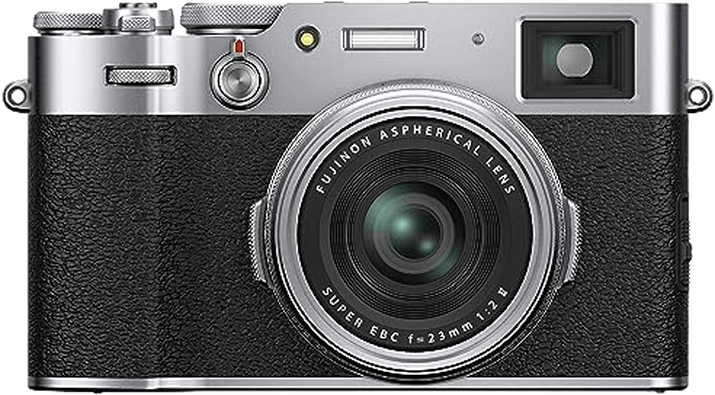Fujifilm X100F vs X100V Comparison
Fujifilm X100F

Fujifilm X100V

The Fujifilm X100V outperforms the Fujifilm X100F with a score of 69/100, compared to the X100F’s 59/100. Both cameras are mirrorless and have similar dimensions and weight, with the X100V being slightly larger and heavier. The X100V was released in 2020, while the X100F came out in 2017.
The X100V’s higher score highlights its improved features and performance over the X100F. Despite the $100 price difference, the X100V offers better value for its features. However, the X100F still has its merits, especially for those who prefer a lighter camera and are on a budget.
Taking these factors into account, the Fujifilm X100V is the superior camera, but the X100F can still be a viable option for some photographers.
Fujifilm X100F vs X100V Overview and Optics
The Fujifilm X100V wins in the optics comparison with a score of 66/100, while the Fujifilm X100F scores 64/100. Both cameras share several common specifications, such as having a CMOS sensor, an APS-C sensor size, and no image stabilization. Additionally, both cameras feature a non-interchangeable fixed lens mount, and their sensors are not scored by DXOMARK.
The X100V surpasses the X100F in terms of megapixels and shooting speed. It has 26 megapixels, compared to the X100F’s 24 megapixels, providing higher resolution images. The X100V also boasts a faster shooting speed of 11 frames per second, compared to the X100F’s 8 frames per second, allowing for better capture of fast-moving subjects.
The X100F, on the other hand, has the X-Processor Pro, while the X100V has the more advanced X-Processor 4. Despite this difference, the X100F remains a strong contender in the optics department, with only a 2-point difference in score compared to the X100V.
In terms of optics, the Fujifilm X100V is the better choice due to its higher resolution and faster shooting speed. However, the Fujifilm X100F remains a solid option, as the differences between the two cameras are relatively small. When making a decision, potential buyers should consider their specific needs and preferences, such as image resolution and shooting speed, to determine which camera best suits their requirements.
Fujifilm X100F vs X100V Video Performance
The Fujifilm X100V outperforms the X100F in video capabilities, scoring 91/100 compared to the X100F’s 70/100. Both cameras share some common features, such as the built-in time-lapse functionality. However, the X100V surpasses the X100F in several aspects, making it the superior choice for video recording.
The X100V offers 4K video resolution, with maximum dimensions of 4096 x 2160, while the X100F only provides Full HD resolution with dimensions of 1920 x 1080. This significant difference results in the X100V producing higher quality, more detailed videos. Additionally, the X100V has a maximum video frame rate of 120fps, double the X100F’s 60fps. This higher frame rate allows for smoother video playback and better slow-motion effects.
The X100F does not have any particular advantages over the X100V in terms of video capabilities. Its lower video resolution and frame rate make it less suitable for users seeking high-quality video recording.
Given the differences in video quality, frame rate, and resolution, the Fujifilm X100V is the clear winner in this comparison. Its superior video capabilities make it a better choice for those who value high-quality video recording and smooth playback. The X100F, while still a capable camera, falls short in the video department when compared to the X100V.
Fujifilm X100F vs X100V Features and Benefits
The Fujifilm X100V emerges as the winner with a feature score of 85/100, while the Fujifilm X100F scores 57/100. Both cameras share several common specifications, such as a 3-inch screen size, flip screen, no GPS, and the presence of WIFI and Bluetooth capabilities.
The X100V outperforms the X100F with its higher screen resolution of 1,620,000 dots compared to the X100F’s 1,040,000 dots. This results in a sharper and clearer display for better image review and composition. Additionally, the X100V includes a touchscreen, making it more convenient and user-friendly for photographers to navigate through settings and control camera functions.
The X100F, on the other hand, lacks a touchscreen, which may disappoint some users who prefer the ease of use that this feature provides. However, this camera still offers a flip screen and Bluetooth connectivity, which are valuable features for many photographers.
To conclude, the Fujifilm X100V outshines the X100F with its higher feature score, improved screen resolution, and touchscreen capabilities. While the X100F has some advantages, such as a flip screen and Bluetooth connectivity, it falls short in comparison to the X100V. Photographers seeking a camera with better features and performance should consider the Fujifilm X100V as their top choice.
Fujifilm X100F vs X100V Storage and Battery
The Fujifilm X100V outperforms the X100F in storage and battery with a score of 37/100 compared to the X100F’s 21/100. Both cameras share the same storage specifications, having one memory card slot and accepting SD, SDHC, and SDXC (UHS-I compatible) memory cards.
The X100V’s superiority is evident in its battery life and charging capabilities. It offers 420 shots per charge, while the X100F provides 390 shots. Furthermore, the X100V has the added advantage of USB charging, which the X100F lacks.
On the other hand, the X100F does not have any notable advantages over the X100V in terms of storage and battery. This makes the X100V a clear winner in this aspect, providing users with longer battery life and convenient USB charging.
Fujifilm X100F vs X100V Alternatives
Still not ready to make a decision? Check out our other popular camera comparisons for inspiration:
